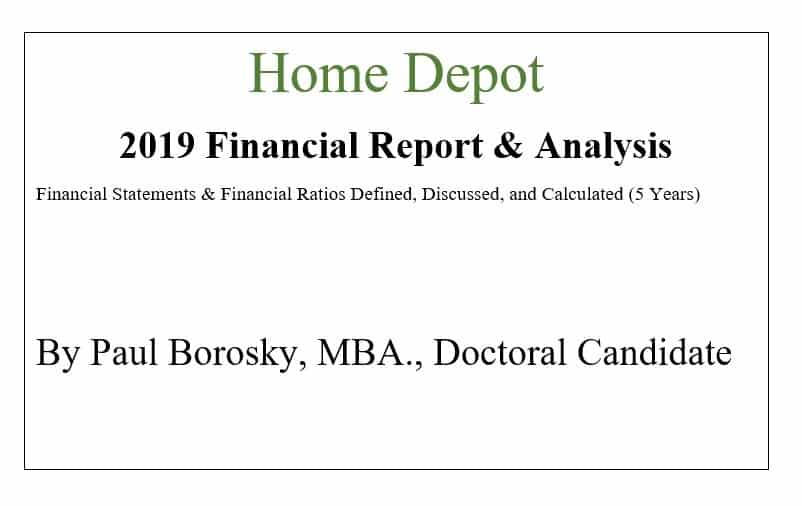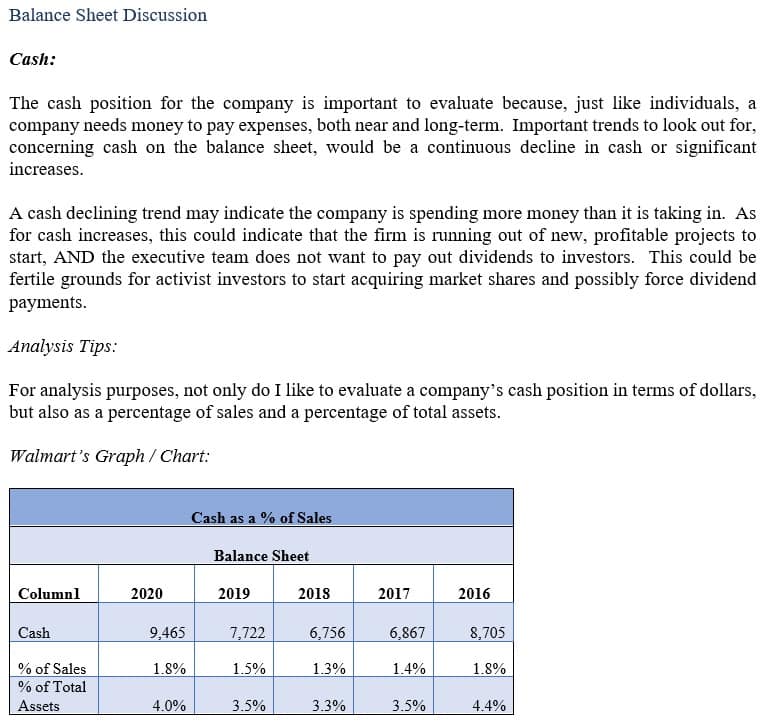Home Depot Financial Statements and Financial Ratios Analyzed
🚀 Build Your Financial Analysis Skills with Home Depot's 2022 Insights! 📊
Home Depot 2022 Beginner’s Guide Introduction:
Hello, future financial architects! Are you ready to construct a solid foundation in financial analysis with Home Depot's 2022 data? Introducing "Home Depot 2022: Beginner's Guide to Financial Analysis," your go-to resource from Quality Business Consultant, penned by the finance savvy Paul Borosky, MBA. This guide goes beyond mere numbers; it's your blueprint for deciphering the fiscal structure of one of the leading players in the retail home improvement sector!
Why You'll Love This Guide:
- Expert Guidance: 🎓 Let Paul Borosky, MBA, be your mentor through Home Depot's 2022 financial landscape, provided by Quality Business Consultant.
- Summary Financial Breakdown: 📉 Analyze Home Depot's income statements and balance sheets for 2022, gaining insights into the company's financial robustness.
- Comprehensive Ratio Analysis: 🧮 Delve into over twenty crucial financial ratios to evaluate Home Depot's fiscal health and operational efficiency.
- Accessible Financial Concepts: 📚 Our "In other words" sections demystify complex financial terminology, making them engaging and easy to understand.
- Tailored Analytical Advice: 💡 Benefit from Paul's customized analysis tips to sharpen your financial analysis skills, useful in both academia and the business world.
- In-Depth Insights with Detailed Report: 🔍 Enhance your understanding with our "Financial Analysis & Report," offering a thorough examination of Home Depot, integrating AI insights with Paul Borosky's seasoned expertise.
Guide Highlights:
- A user-friendly Legal Disclaimer
- An inspiring Forward to kickstart your financial exploration
- Rigorous examinations of Income Statements and Balance Sheets for 2022
- In-depth Financial Ratios exploration to empower your analytical prowess
- A toolbox full of financial insights waiting for you!
Table of Contents Sneak Peek:
- Income Statement Analysis: Exploring revenue, expenses, and profitability insights
- Balance Sheet Review: Understanding assets, liabilities, and equity – the keystones of financial solidity
- Financial Ratios Decoded: Gaining the skills to assess Home Depot's financial performance
Who's This For?
Perfect for ambitious business students and budding entrepreneurs, this guide is your toolkit for mastering financial analysis with a focus on Home Depot.
Lay the Foundation for Your Financial Expertise:
Elevate your financial literacy with "Home Depot 2022: Beginner's Guide to Financial Analysis." Transform intricate financial data into actionable insights.
Additional Note: This beginner's guide is designed to establish a foundational understanding of essential financial principles, centering on income statements, balance sheets, and critical financial ratios for their analysis. It offers a summarized snapshot of Home Depot's financials for 2022, providing targeted data, calculations, and ratios to aid your analytical journey. While the guide provides the tools for financial exploration, the comprehensive analysis is yours to undertake. For those desiring a detailed, company-specific financial examination, our "Financial Analysis & Report" delivers meticulous insights, merging AI technology with Paul Borosky, MBA's analytical expertise.
PDF/Downloadable Version

Sample Financial Report


Home Depot: Brief Summary
Home Depot has its headquarters in Atlanta, Georgia. The company competes in the consumer cyclical sector specifically in the home improvement retail industry. At present, the organization employs approximately 400,000 individuals. Home Depot generates most of the revenues from selling retail home improvement products to consumers and businesses. Popular home improvement items sold may include building materials, lawn and garden products, and other do-it-yourself supplies.
From a financial perspective, Home Depot has a market capitalization of approximately $285 billion. Their beta is 1.06. This indicates that Home Depot is slightly more risky of an investment as compared to the overall market. The company does pay dividends. At present, Home Depot’s dividend yield is approximately 2.26%. The organization 52-week stock range has fluctuated between $140.63 to $267.80.
Home Depot Financial Report Sources
“Home Depot 2019 Company Analysis… For Beginners: Financial Statements and Financial Ratios: Defined, Discussed, and Analyzed for 5 Years” was written by, Paul Borosky, MBA. and owner of Quality Business Plan. In this report, I used Home Depot 2018 10k, 2017 10k annual report, 2016 10k annual report, 2015 10k annual report, and 2019 10k annual report as the basis for information gathering.
Section 1: Home Depot Income Statement Analyzed
In this section, I walk through a broad definition as to what an income statement is and why it is important. From this, I then discuss and define income statement line items, such as revenues, gross profits, etc. in detail. After each line item is defined and discussed, I finally offer a summary analysis of Home Depot's important income statement line item trends from 2015 to 2019, in most cases.
Home Depot Revenue Growth.
In 2015, Home Depot’s revenues were approximately $83.1 billion. In the next four years, the organization would continually grow the revenues ending 2019 with approximately $108 billion in revenues. Common sense would dictate that this type of trend should be commonplace with multinational organizations. However, this cannot be further from the truth. With this said, if the organization is able to continue their impressive 6.8% revenue growth annually, then the company should be well suited for long-term prosperity.
Home Depot Income Statement 2019 |
|||||
| Column1 | 2019 | 2018 | 2017 | 2016 | 2015 |
| Revenues | 108,203 | 100,904 | 94,595 | 88,519 | 83,176 |
| COGS | 71,043 | 66,548 | 62,282 | 58,254 | 54,787 |
| Gross Profit | 37,160 | 34,356 | 32,313 | 30,265 | 28,389 |
| SG&A | 18,513 | 17,864 | 17,132 | 16,801 | 16,280 |
| Depreciation | 1,870 | 1,811 | 1,754 | 1,690 | 1,640 |
| R & D | - | - | - | ||
| Other | |||||
| Operating Expenses | 21,630 | 19,675 | 18,886 | 18,491 | 17,920 |
| EBIT | 15,530 | 14,681 | 13,427 | 11,774 | 10,469 |
| Other Income | |||||
| Interest Expense | 1,051 | 1,057 | 972 | 919 | 830 |
| EBT | 14,556 | 13,698 | 12,491 | 11,021 | 9,976 |
| Taxes | 3,435 | 5,068 | 4,534 | 4,012 | 3,631 |
| Net Income | 11,121 | 8,630 | 7,957 | 7,009 | 6,345 |
Section 2: Home Depot Balance Sheet Analyzed
For the Home Depot balance sheet, I again go through each important line item from the balance sheet. In reviewing each line item, I will define their balance sheet line item, such as cash, property, plant and equipment, and liabilities between 2015 to 2019. Next, I then offer a summary analysis of their important balance sheet line items.
Home Depot Accounts Receivable.
In 2015, Home Depot had an Accounts Receivable of approximately $1.4 billion. In my opinion, their Accounts Receivable is probably funds waiting to be paid by commercial accounts. In the next two years, the organization would increase its Accounts Receivable ending 2017 with approximately $2 billion. In the next two years, their Accounts Receivable would slightly fall ending 2015 with $1.9 billion. The leveling off of Accounts Receivable indicates that the company may be dealing less with or at least not growing their commercial accounts as much as they are with their retail sales. For investors, if this segment of the organization starts to decline, then total revenues meet not be far off.
Home Depot Summary Balance Sheet 2019 |
|||||
| Column1 | 2019 | 2018 | 2017 | 2016 | 2015 |
| Cash | 1,778 | 3,595 | 2,538 | 2,216 | 1,723 |
| Short Term Investment | |||||
| Account Receivable | 1,936 | 1,952 | 2,029 | 1,890 | 1,484 |
| Inventory | 13,925 | 12,748 | 12,549 | 11,809 | 11,079 |
| Other | |||||
| Current Assets | 18,529 | 18,933 | 17,724 | 16,484 | 1,016 |
| Net PPE | 22,375 | 22,075 | 21,914 | 22,191 | 22,720 |
| Goodwill | 2,252 | 2,275 | 2,093 | 2,102 | 1,353 |
| Other | |||||
| Total Assets | 44,003 | 44,529 | 42,966 | 41,973 | 39,946 |
| Accounts Payable | 7,755 | 7,244 | 7,000 | 6,565 | 5,807 |
| Accrued Expense | 1,506 | 1,640 | 1,484 | 1,515 | 1,391 |
| Accrued Taxes | 11 | 54 | 25 | 34 | 35 |
| Notes Payable | 1,339 | 1,559 | 710 | 350 | 290 |
| LT Debt - Current | 1,056 | 1,202 | 542 | 77 | 38 |
| Other | |||||
| Total Current Liabilities | 16,716 | 16,194 | 14,133 | 12,524 | 11,269 |
| LT Debt | 26,807 | 24,267 | 22,349 | 20,789 | 1,844 |
| Other | |||||
| Total Liabilities | 45,881 | 43,075 | 38,633 | 35,657 | 30,924 |
| Common Stock | 10,578 | 10,192 | 9,787 | 9,347 | 8,885 |
| Treasury | 58,196 | 48,196 | 40,194 | 33,194 | 26,194 |
| Retained Earnings | 46,423 | 39,935 | 35,519 | 30,973 | 26,995 |
| Other | |||||
| Total Equity | (1,878) | 1,454 | 4,333 | 6,316 | 9,322 |
| Total Equity & Liability | 44,003 | 44,529 | 42,966 | 41,973 | 39,946 |
Section 3: Home Depot Financial Ratios Analyzed
For this section, I have chosen several different financial ratios to review for Home Depot from 2015 to 2019. In reviewing each of their financial ratios, I first start with defining the financial ratio. Next, I supply the financial formula for calculating the specific ratio. Finally, I offer a brief analysis of their important Financial ratios.
Home Depot Current Ratio.
Home Depot’s current ratio ended 2015 at 1.36. In the next four years, the organization would continuously reduce its current ratio ending 2019 at 1.11. Because the organization does receive significant cash influx on a daily basis, having a current ratio at .8 or .9 may indicate optimal usage of short-term assets. From this lens, investors may consider a 1.11 current ratio as not optimal.
Home Depot Total Asset Turnover.
Home Depot had a total asset turnover in 2015 of 2.08. In the next four years, the organization would increase its total asset turnover in 2019 at 2.46. This indicates that the company is continually finding ways to improve or rather make money on its assets. As with other segments of their financials, Home Depot seems to be doing an excellent job with this ratio.
Home Depot Return on Assets.
Home Depot had a return on assets of 15.88% in 2015. In the next four years, the organization would increase its return on assets to 25.27% in 2019. The above-average growth and return on assets is a similar trend as other ratios for the organization. Just another reason why this organization may be an advisable investment.
Home Depot Debt ratio.
Home Depot ended 2015 with a debt ratio of 4.62%. For a multinational organization, this debt ratio is significantly low. When an organization has such a low debt ratio, the firm is missing out on tax write off opportunities as well as making money on borrowed money. In the next four years, the company would increase its debt ratio substantially ending 2019 at 60.92%. It seems like the organization went from one extreme to another.